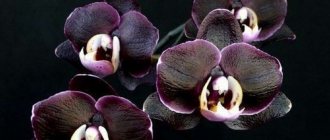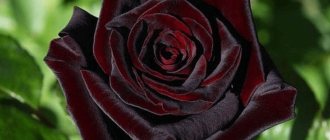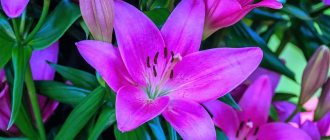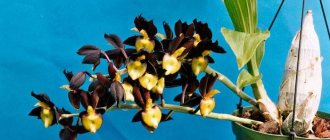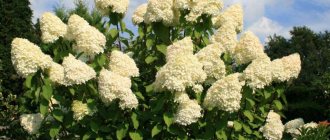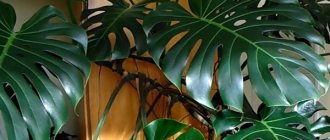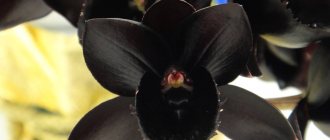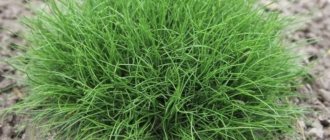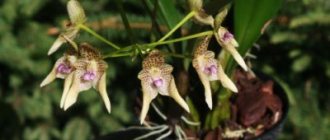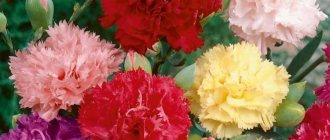Cymbidium is an orchid native to the tropics . There are about seventy varieties in nature. Now flower shops sell hybrids of natural forms that bloom in different months.
If you provide proper care and create a favorable indoor climate for growth, you can achieve alternate flowering of different varieties at home. We present to your attention their varieties, photos and names.
Cymbidium aloifolium
Cymbidium aloifolium
The species is distributed in South Central China, Assam, Bangladesh, eastern Himalayas, India, Nepal, Sri Lanka, Andaman Islands, Myanmar, Thailand, Laos, Cambodia, Vietnam, Malaysia, Java and Sumatra, in evergreen, semi-deciduous and deciduous forests and savannah woodlands at altitudes up to 1100 meters above sea level.
They grow as epiphytes or lithophytes on open mossy rocks.
Hybrid variety is miniature, up to 30 cm in height. The flower has a yellow center and a purple stripe running along the petals.
In the wild, the stem of cymbidium reaches 1.5 meters.
Escape of sympodial type. Pseudobulbs are poorly developed, ovoid, 1.5-2.5 × 1-1.5 cm, completely hidden by sheaths of 3-4 (up to 6) leaves. The roots are fleshy and long.
Inflorescences are basal, vertical, 15-67 cm long, 3-9 (less often 13) flower racemes.
The flowers do not fade for 2-3 weeks, are strongly and pleasantly fragrant, 3-5 cm in diameter.
Petals and sepals are straw-yellow with green with 5-7 varying degrees of pronounced longitudinal veins of red or red-brown color.
The petals often have red-brown spots and the central vein is more pronounced.
The lip is pale yellow, green, sometimes white with red-brown veins and spots.
Diseases and pests, methods of elimination
At times, cymbidium becomes a victim of various diseases and pest attacks.
| Symptoms | Cause | Elimination methods | Prevention measures |
| Yellowish stains appear on the leaves. | Chlorosis is soil salinization. | Spray with fertilizer solution. | Filter or settle water for irrigation. This will prevent excess calcium from entering the substrate, which disrupts metabolism, in particular the absorption of iron. |
| Black weeping spots appear at the joints of the leaf blade and stem. The leaves are starting to fall. | Fusarium is a fungal disease. | Cut out the infected areas, disinfect the wounds, and after drying, treat with Fundazol. Transplant the flower into a new substrate. | Avoid waterlogging and salinization of the soil. |
| The foliage and stems turn black, and mold appears near the roots. There is a smell of rot. | Root rot. | The plant cannot be destroyed along with the pot; it cannot be cured. | Do not allow waterlogging or stagnation of water after watering. Immediately drain excess liquid from the pan. |
| Leaves and flowers bend and curl. Light spots become noticeable on the petals. | Viral mosaic. | ||
| A sticky whitish coating appears on the surface of the plant. Small, light green insects are often visible to the naked eye. | Aphid. | Wash the orchid with soapy water and rinse under a warm shower. Treat with an insecticide against aphids (for example, Fitoverm). | Ensure the required level of humidity in the room - not lower than 50-60%. Do not allow the substrate to dry out. |
| The leaves lose color and brown tubercles appear on them. | Shield. | Manually remove all pests from the surface of the flower, treat the leaves and stems with a soap solution, and then with an insecticidal preparation (for example, Phosbecid or Metaphos). |
Cymbidium eburneum
Cymbidium eburneum
The species is native to China and Myanmar.
Eburneum is also known as “Ivory”, which is associated with the special cream color of the buds. It has large flowers (up to 12 cm in diameter).
Peduncles reach 30 cm in height. The plant has narrow leaves of a rich green hue.
Thick bulbs have a stem-like shape.
The smell of the flower is reminiscent of lilac.
Reviews
Catherine. “I decided to conduct an experiment and propagate my Cymbidium with pseudobulbs. I separated the bulbs from the bush, left a few with leaves and a couple without leaves. So, those bulbs that had leaves withered. Looks like they won't be of any use. And the bulbs without leaves are whole and fleshy. Two months later, new shoots appeared. I will continue to take care and wait for the buds.”
Olga. “I already had a small collection of phalaenopsis when I purchased my first cymbidium flower. On the advice of a friend, when replanting a flower, I added peat to the soil. Since I water my orchids by immersion in a bowl of water, all the peat from the cymbidium pot floated out. My advice to you is not to add it to the soil if you intend to soak your orchids in the same way.”
Oksana. “My wedding bouquet consisted of sprigs of blooming cymbidium. The arrangement was made with a florist, and I was surprised how the delicate flowers would survive such a busy day. And in general, for the first time I saw bouquets with the Cymbidium orchid. So, two weeks have already passed, the bouquet is safe and sound. The flowers are incredibly beautiful, I never get tired of admiring them; The smell of flowers is unobtrusive and pleasant.
I became interested in this flower, collected information about it and decided to buy cymbidium in a pot. This weekend I’m going to the gardening hypermarket.”
Cymbidium lancifolium
Cymbidium lancifolium
Cymbidium lancifolium is the most common species in nature. Most often found in India or China.
The plant is low, the leaves reach about 30 cm in length. The inflorescence is approximately the same; up to eight flowers with a diameter of 2.5 to 5 cm can be seen on it.
The center of each petal is marked with a bright pink or purple vein. The leaves are thin and pointed.
The variety is famous for its fragrant flowers.
In greenhouses it blooms in March or early April for a long time, up to several weeks in a row.
In nature, in the southern regions of its growth, this type of orchid can bloom almost all year round.
Popular types of cymbidium: photos and descriptions of varieties
No matter how popular this flower is at present, it cannot be purchased at any flower shop. Hybrids are always presented on display cases, but not the natural type of cymbidium.
Cymbidium aloelia.
Cymbidium aloelia.
Cymbidium aloelia.
Cymbidium aloelia.
Cymbidium aloelia.
Cymbidium aloelia.
Cymbidium aloelia.
Cymbidium aloelia.
Cymbidium dayanum
Cymbidium dayanum
The species got its name in honor of the British orchid collector John Day, who created a large number of drawings of these plants.
The species is widespread in Sikkim and northeast India, Myanmar, Thailand, Cambodia, Laos, Vietnam, China, Taiwan, Japan, the Ryukyu Islands, Malaysia, Sumatra, Borneo, Celebes and the Philippines.
In Thailand, this orchid is found in the north in mountainous regions at an altitude of 1100–1500 m, and in the east and southeast at an altitude of 800–1200 m.
In Malaysia it can be found in many places at an altitude of 150–1200 m. In China it grows on trees in open forests or on the slopes of gorges at an altitude of 300–1600 m.
In Sumatra it can be found on the lower branches of trees or on steep slopes. In the Philippines, this species grows in the ground, but can sometimes be found in tree hollows at altitudes of 300–1800 m.
Large sympodial epiphyte or terrestrial orchid with dense herbaceous growths.
Pseudobulbs are 2–5 cm long and 1.5–2.5 cm wide. They are quite small, spindle-shaped or ovoid, covered with leaf bases that overlap each other.
The pseudobulb can have from 4 to 12 leaves arranged in two rows. They are curved, narrow, thin, with pointed tops. The leaves are usually 30–60 cm long, but can sometimes reach 100 cm.
The peduncle reaches a length of 30 cm. At first it grows straight, but then bends and hangs down. The flowers are 6 cm in diameter, collected in a rather loose cluster.
The buds are small, have an elongated shape, the center of each petal is crossed by a wide burgundy stripe. The central part is a tucked lip, painted white.
Flowering begins in August and ends in December. The orchid prefers a climate close to subtropical.
External characteristics
Pseudobulbs
Pseudobulb is a part of the stem with a thickening in which the plant accumulates moisture and nutrients.
The bulbs are located close to each other. Height - from two to ten centimeters . At the base of the bulbs there are leaves and peduncles.
Mature plant height
Plant growth depends on the Cymbidium variety:
- giant - up to two meters;
- dwarf - up to 20cm.
The growth of Cymbidium depends on its species.
Number of leaves
The number of leaves depends on the number of bulbs in the pot. One bulb produces an average of 5–7 leaves. In a small pot, 10–12 bulbs and, accordingly, 70 leaves . The lifespan of a leaf is about three years, then it dies and a new one grows in its place.
Maximum peduncle length
The size of the plant's peduncle also depends on the variety. In Cymbidium giganteum and Lowe, it can reach 75 cm and contain up to thirty-five buds. The shape of the peduncle is straight or hanging.
Flower diameter and shape
Size - from 3 to 13 cm. The flower has five petals. Depending on the variety, the shape of the flower can be round or elongated. Sepals and petals can be plain or interspersed with a different color. The lip is bright, three-lobed.
REFERENCE! The lip is a growth inside the flower, similar to a boat or a boat, thanks to which the orchid got its name “Cymbidium”.
Cymbidium tracyanum
Cymbidium tracyanum
In nature, Cymbidium tracyanum is found in Southeast China, Northern Thailand and Myanmar.
It grows epiphytically on trees, lithophytically on rocks and even directly on the ground at an altitude of 1200 to 1900 meters above sea level.
The pseudobulbs are oval, divided into 6-7 segments, about 12 cm in length, and grow very closely to each other.
A distinctive feature of the color is the lip with wavy edges of a cream color with red splashes.
Large yellowish-green flowers with small purple spots along the edges sometimes reach 15–20 cm in diameter.
The flowers are fragrant (smell of cardamom).
The front of the cream lip is also spotted. Its edges are wavy or fringed. Reaches a height of 1.2 m, in September at least 20 flowers appear on each brush.
The flowering period in greenhouses is from September to December, in nature it can last about a year.
Main features of flowering
The necessary conditions
Under what conditions does a peduncle appear:
- difference between day and night air temperatures of 5 °C;
- fertilizing with complex fertilizers with potassium and phosphorus, start fertilizing when new shoots grow to 10 cm after a dormant period;
- supplementary lighting in winter. In case of insufficient lighting, the peduncle will either not appear at all or will be weak, with a small number of buds.
Time
For different varieties, the season of active growth begins in late winter or early spring , and flower buds are laid in August - October. During this period, the plant needs diffused sunlight.
Peduncles form in the internodes, and as they grow, they break through the leaf petioles. Reduce watering to once every 1.5 weeks.
Duration
In a healthy plant, flowering lasts from 1.5 to 3 months . Use potassium-phosphorus fertilizers only before the flower stalk begins to form.
IMPORTANT! There is no need to try to extend the life of the buds with the help of fertilizing. Fertilizing can cause flowers to drop or flowering to end quickly.
Care
A separate article is devoted to caring for cymbidium on our website. Here we will briefly go over some points of care.
How to care for a plant during flowering:
- stop applying fertilizers;
- moderate watering as the soil dries;
- avoid drafts and sudden temperature changes;
- make a support for the peduncle.
During flowering, the peduncle needs support.
Is it possible to do it again?
An old bulb that already had a peduncle is not capable of re-blooming . The peduncle is formed on new, young pseudobulbs.
Cymbidium lowianum
Cymbidium lowianum
In nature, it is found in India and in its homeland in Burma.
A large-flowered orchid with buds opening 20 cm or more. It has a thick meter-long peduncle. The leaves extend 0.75 m.
One inflorescence can contain up to 35 large flowers. The flowers are light green with a hint of yellow.
The lip has three dark crimson lobes, with a bright yellow stripe running along the edges of the middle lobe. On the front of the lip there is a scarlet spot in the shape of the Latin letter “V”.
The hybrid variety “Lilliput” grown on its basis is considered the most popular.
Cymbidium Lowe blooms in greenhouses from February to July. In nature, this period can last almost a year.
Transfer
The key to healthy growth of Cymbidium is the choice of high-quality soil and container for planting. Since the plant feeds through aerial roots, ordinary soil is not suitable. Moss, tree bark, and charcoal would be ideal.
You can buy a ready-made mixture, or you can prepare it yourself, observing the proportions. The pot must have many holes and be transparent . In order to replant without harm to the plant, you need to adhere to the following plan:
- Taking care not to damage the roots, carefully remove from the old pot. Afterwards, it is recommended to leave the plant in water at room temperature to make the roots easier to untangle.
- Inspect the roots, get rid of damaged, dry ones. Clean the pseudobulbs. All cuts must be treated with charcoal. Leave for 20 minutes and let the wounds dry.
- In the meantime, start preparing the pot. Don't forget about drainage, it can be expanded clay or broken brick. Everything should not be from a large faction.
- Next we proceed to planting. Carefully, trying not to damage the roots, place the plant in the center of the pot. We fill the free space with substrate. Under no circumstances should we bury pseudobulbs!
- We shade the transplanted flower. For the first 5 days, Cymbidium does not need watering.
- After a week, we send the transplanted plant to the rest of the inhabitants of the window sills.
Cymbidium giganteum
Cymbidium giganteum
grows in the Himalayas. It is one of the largest epiphytes.
The bases of large peduncles are covered by leaves, their shape is closer to lanceolate, the edges are sharp. About 15 fragrant buds appear on one peduncle.
Yellow-green buds are covered with brown stripes. The lip is creamy, spotted and striped. The diameter of the buds is 12 cm, the length of the inflorescence is 0.6 m.
Blooms in November, fades in April. The flowers do not dry out for a long time, remaining fragrant and alive for 3-4 weeks.
The Red Chile variety is popular: the compact bush is decorated with deep red flowers.
General information about the flower
This variety of orchid is distinguished by dense paniculate inflorescences. It was obtained as a result of repeated crossings of English species. Cymbidium ampelous and Cymbidium cascade look very picturesque. When branches strewn with flowers fall from the pot in a fragrant wave, it creates an amazing effect.
In nature, varieties of this orchid are often found in the humid tropics of India, Thailand, Indonesia, and Burma. These varieties have been known to mankind for a long time, more than 2000 years. Confucius also admired them, calling them the “kings” of aromas.
Cymbidium unites more than 60 plants. All of them are characterized by long narrow leaves, with rounded or pointed ends, a strong pronounced aroma, and long flowering (about two and a half months).
The color can be varied. There are white, green, orange, red, yellow, pink, brown, cream and other cymbidium. Hybrids of this plant bloom at different times of the year, which allows you to enjoy the beauty of these orchids almost throughout the year.
The dwarf cymbidium flower, bred in Japan, is very popular. Caring for orchids of this variety is relatively simple. Therefore, if you haven’t yet chosen a beauty for yourself, pay attention to Cymbidium.
Cymbidium pumilum
Cymbidium pumilum
is native to evergreen and deciduous forests of northern Vietnam and the Chinese province of Yunnan. It can also be found in Taiwan and Japan, where it was subsequently transported.
The plant is distinguished by the peculiarity that the petals change color from olive green to red after pollination.
The leaves of the plant are long, pointed, and appear in large numbers. One peduncle can bear up to eight flowers.
This variety combines compact plants with thin peduncles. The white lip contrasts with the red-brown petals. The flowers look like stars.
The buds open to 10-12 cm. It blooms in December.
Growing conditions
Temperature
The optimal temperature in summer is up to +28 °C; in autumn in spring - up to +18 °C . At very high temperatures and dry air, plant growth stops; at low temperatures – flowers are dropped, leaves are damaged by diseases.
While maintaining the flower, make differences between the air temperature during the day and night; the difference in thermometer readings should be at least 5 °C.
During flowering and during the dormant period, which begins immediately after the last petals are dropped, there is no need for temperature fluctuations during the day.
Plant location
- during active growth - the window sill of a south or south-east window, with mandatory shading during daytime sunny hours;
- during flowering - remove from a bright windowsill;
- during the dormant period , move the pot with the plant to a darker place.
Humidity
The Cymbidium orchid, as a representative of the tropics and subtropics, is demanding of high indoor humidity . The humidity level is up to 60%.
How to achieve this indicator:
- use air humidifiers and indoor fountains;
- spray the leaves and air around the plant twice a day;
- Place an open container of water next to the flower.
ADVICE! To determine the level of air humidity, purchase a hygrometer. It will help determine the need for spraying and introducing other methods of increasing humidity.
Priming
The soil must be porous and hygroscopic . Soil preparation option - take in equal quantities:
- sphagnum moss;
- humus or peat;
- pine bark;
- coconut flakes.
Substrate composition for Cymbidium.
Capacity
- plastic or clay pot ;
- there is no need to use only a transparent pot, as for phalaenopsis;
- the depth should be such as to place a drainage layer at the bottom. In this case, the bulbs should be at ground level.
Lighting
- The Cymbidium orchid grows well and blooms in indirect sunlight . The sun's rays during the daytime in summer can burn the leaves;
- in the summer months, place the orchid on the east or north window, in the cold months - on the south or southeast;
- on winter days, supplement the plant with a phytolamp to extend daylight hours to 12 hours.
Cymbidium ensifolium
Cymbidium ensifolium
is an unpretentious plant. The stem is erect, from 15 to 65 cm long. The peduncle contains up to 9 small buds, no more than 3-4 cm in diameter. The petals are pale yellow, each with burgundy veins.
The lip is pale yellow or light green, with dark coral stripes in the middle and brown stripes on the sides.
Based on the wild species, such hybrid varieties as Peter Pan, Lovely Melody and Golden Elf have been created.
Blooms all winter and most of spring.
Some problems
- Falling buds or flowers. Lack of phosphorus. You just need to apply the appropriate fertilizer.
- The peduncle and bulbs shrivel and wither, and the petals have grey-brown spots. This is gray rot from overflow. If the stem is healthy, the cymbidium orchid tender sakura will survive . Improper watering also leads to root rot. The affected parts are removed, watering and fertilizing are suspended and the air temperature is increased.
- Viral mosaic. Cymbidium refuses to bloom, the sprouts become small and dry. Infection often occurs through dirty equipment . The plant dies;
- Edema leaves. Growths appear that look like bubbles filled with liquid. The plant was in the cold after watering. The affected parts are cut off.
- Yellow leaves indicate that the cymbidium is hot and the air is too dry, while curled leaves indicate a lack of microelements and a very low temperature .
- Black spots on the leaves are a consequence of sunburn or waterlogging of the soil.
Note! Beginning gardeners are often bothered by white dots on cymbidium. This may not always mean disease or insect damage. A nearby humidifier, a draft, or a sudden change in temperature can affect the plant (it is standing on a warm windowsill, and you closed the window in winter).
Cymbidium wins the hearts of gardeners at first sight . Having created the most comfortable conditions for the plant, you can admire its fragrant exotic flowers to your heart’s content.
Cymbidium insigne
Cymbidium insigne
A beautiful orchid with light or bright pink buds up to 8 cm in diameter.
The petals are spotted with red, and there are spots along the edges of the curved back front of the lip.
The stem reaches a height of 0.8 m. Each stem has from 9 to 15 inflorescences. Blooms in February.
Reproduction
Cymbidium propagates in two ways - by dividing the bush and by seeds.
Dividing the bush
This is the easiest way to reproduce. It is combined with plant transplantation so as not to disturb the root system again.
- Remove the cymbidium from the pot.
- After cleaning, divide the plant into several parts, leaving on each divided plant several green bulbs and one brown, old one. It is in old bulbs that the cymbidium orchid retains useful substances, which it then uses in case of unfavorable conditions.
- Remove rotten and dry roots, sprinkle the cuts with charcoal and dry.
- Plant the cuttings in a suitable substrate. Spray, water moderately and keep in a warm place.
- The emerging young leaves will signal successful rooting.
Cymbidium Ice Cascade
Cymbidium Ice Cascade
grows naturally in Australia and Southeast Asia. It is an ampelous variety of cymbidium.
The flowers are white and small. There are up to 300 flowers in racemes. They bloom gradually.
The flowering period extends over many months. This feature, as well as the unpretentiousness of the plant, make it very popular among gardeners for home cultivation. The smell is pleasant.
Cymbidium flowering at home. Why doesn't the cymbidium orchid bloom?
This orchid blooms for 1 to 2 months, mostly blooming in winter, but there are varieties that bloom in summer.
In order to make cymbidium bloom, you must follow the main rule - this is to observe the temperature regime, which should be no more than 22 °C. This exactingness is due to the fact that at higher temperatures the orchid sets buds poorly or not at all. In summer, this condition is very difficult to fulfill; in winter, lowering the temperature to the required level at home is much easier.
Orchids at the age of 3 years enjoy the most magnificent flowering.
The main requirements for growing conditions for cymbidium for lush flowering:
- Daily temperature difference;
- Keep temperature not higher than 22 °C;
- Bright lighting without exposure to direct sunlight.
Cymbidium kanran. ©Keisotyo
Cymbidium Vogels Magic
Cymbidium
'Vogel's Magic' (Cymbidium Tethys x Cymbidium Vogelsang) – has a long and complex pedigree.
The variety owes its charm to the very interesting spotted color of the flowers, an unusual and complex shade.
The flowers are medium in size, beautifully shaped with a very showy lip.
Petals of various shades of pink with large dark purple spots. The lip is lighter, but the spots on it are larger.
The hybrid belongs to compact and miniature varieties with drooping, abundant inflorescences, which are desirable for home collections.
